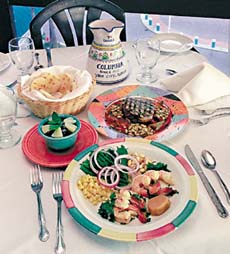
Another Review of Portland's Andian Restaurant run by son of Peru RPCV John Platt
Andean high
09/26/03
BOB HICKS, The Oregonian
Atmosphere: Warmly muted large space that balances between traditional and contemporary style
Must-have dishes: Ceviches (especially mixed seafood); stuffed trout with currant sauce; mango mousse
Vegetarian options: A few well-placed ones, including mushroom, artichoke or fruit ceviches; squash or pepper rellenos; quinoa risotto with mushrooms, asparagus and zucchini
Strength: Fine updated Peruvian cooking
Flaw: Still a few service details to work out.
--------------------
Sitting in Andina on a Friday evening with a pisco sour exploding softly in your brain, you get the feeling it might not be a bad thing in life to be from Peru.
Which, in a way, we all are. At least, when it comes to the dinner table.
It's Peru, after all, that gave the world potatoes and corn, two of its most essential crops. Each has been cultivated in the Andean highlands for as long as 8,000 years -- before the flourishing of the Inca civilization, before the Spanish conquistadors, before the contemporary criolla, or creole, blend of Indians, Europeans, Africans and Asians that make this country a sophisticated cultural crossroads despite its extreme contrasts of poverty and wealth.
As the Tigris and Euphrates of New World agriculture, Peru also has long cultivated quinoa (it means "moon" in the Quechua language), a kind of wonder grain that acts like rice but is bursting with protein out of all proportion to its size.
The Andes are probably the birthplace of the tomato, although, oddly, the fruit that Europeans christened the "love-apple" when it finally made it across the Atlantic is of little consequence in Peruvian cooking -- far less, for instance, than cuy, or guinea pig, a staple meat in the interior that is still sometimes cooked by placing hot rocks into the animal's cavity and warming it through from the inside.
And don't forget the lima bean.
Grab a table at Andina, the crisp and promising new restaurant in the Pearl District, and you'll discover one more Peruvian staple that might trump all the others, or at least bind them together: aji, or hot pepper. Perhaps 300 varieties are grown in the country, and they slide into all kinds of dishes, sometimes in a sauce, sometimes as a background tingle, sometimes as a searing presence.
Peppers put the punch into Andina's anticuchos res, the traditional tasty skewers of grilled yucca and thin slices of marinated beef heart. They enliven conchas a la parmesana, lovely large sea scallops served beautifully in their opened shells. They add the bite to langostinos chicharron, a wonderful crunchy-fresh snack of firm large shrimp rolled in quinoa crust.
You don't come to Andina, in other words, for a culinary whisper. Yet if the food here is robust, it's also subtle, with an illuminating clarity of flavors.
Andina calls its food "novo Peruvian cuisine": Although it serves some classic Peruvian home dishes, this isn't home cooking. (For that, go to El Palmero Restaurante, the decent and authentic Mexican/Peruvian place at 320 S.W. Alder St. downtown.)
Emmanuel Piqueras Villaran, Andina's talented young executive chef, whose background includes a stint at Spain's Michelin three-star restaurant Arzak, gathers his country's rich variety of flavors and gives them a smart, contemporary twist. His menu also reminds us that Peru is a country with a long coastline.
Peru is no more a single culinary region than the United States, where a world of difference rests between a Louisiana gumbo and a Boston baked bean. Geographically and culinarily, Peru breaks roughly into three parts: the coast, with its wealth of seafoods and its cosmopolitan capital of Lima; the Andean highlands, with their rustic flavors and deep cultural history; and the far eastern jungles of the upper Amazon watershed, with their rich tropical fruits (don't miss Andina's ethereal mango mousse).
The coast is where Villaran seems to feel most at home. If there are better ceviches in Portland, I don't know where: Andina serves nine of them, and they're pristine. Mixed seafood ceviche, with mussels, octopus, shrimp and sometimes a firm-fleshed fish that are "cooked" in Key lime juice for the briefest of times, is an ideal interplay of fresh seafood textures, pepper heat, crunchy corn nuggets, sea salt and the cooling tang of cilantro.
Other recent seafood dishes also have sparkled: an albacore and langostino special with hot-pepper sauce over yellow potatoes; a lovely rainbow trout, served whole, stuffed with herbs and Serrano ham and laced together with a currant sauce that's almost like a port reduction. Langostinos a la chifa reflects the Chinese influence in Peru: Ginger, lemon grass and oyster sauce join aji and garlic to set off fine-quality shrimp. The dish, served with a soft purplish quinoa, is sweet with a nice after bite; despite the menu's "spicy!" warning, it's neatly balanced and not too snappy.
Villaran's most recent menu moves a little more into the highlands, most notably with pachamanca del Inca, the classic Andean baked stew that's traditionally made by burrowing a hole in the ground, lining it with heated stones, and layering its ingredients between banana leaves: It's the Peruvian corollary to a New England clambake. Andina's version is slow-cooked in a clay pot (hole-digging not being terribly practical in a restaurant kitchen), with quail, marinated venison, corn kernels, potatoes, yucca, favas and herbs, and a ring of puffy quinoa bread crust around the lid for dipping.
But what Villaran must mean as a signature dish -- at $25, it's $5 more expensive than anything else on the menu -- promises much more than it delivers. Its meats are tough, the favas cruelly brittle and the broth so bland I resorted to smothering it with salt. From a kitchen that usually hits on all cylinders, it's a surprising disappointment.
Andina features a pleasant list of Chilean and Argentine wines, plus regional drinks such as chica morada, a nonalcoholic purple-corn drink that tastes like a cold mulled cranberry juice; the soft drink Inca Kola; and several kicky cocktails made with pisco, Peru's white grape brandy.
Get one of the self-assured, almost roguishly charming native Peruvian waiters and you'll find yourself guided gently but firmly through the menu: "No, not the chicken chicharron. Too dry. Do the langostino; it's much better." Go on one of the frequent evenings when the fine Peruvian guitarist Alfredo Muro and his trio are playing and your mood is likely to kick into happy overdrive.
Little problems persist: uncertainties among some of the servers, a bit of forgetfulness on such niceties as bringing spoons for broths or even seating customers facing the room instead of the rear wall. The multiple menus are a welter of confusion; be sure your server lets you know what's what. And there is the puzzlement of that pachamanca del Inca.
But as things come together, Andina is likely to be an enduring player on the scene, notable both for its good food and its good times. Peruvian cooking is one of the world's most underrated cuisines. In Portland, no more.

